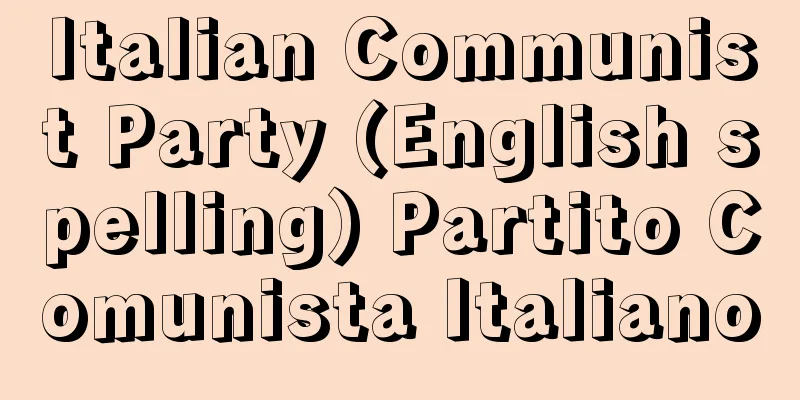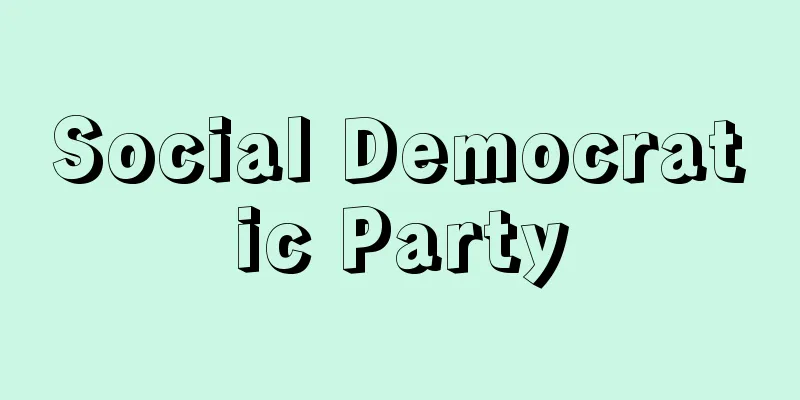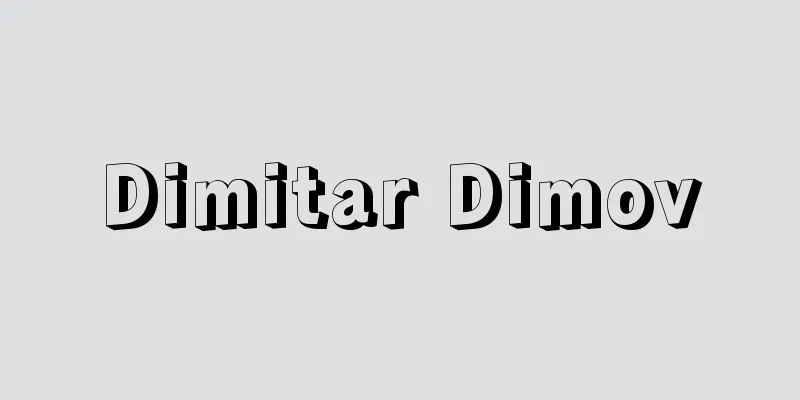Italian Communist Party (English spelling) Partito Comunista Italiano

|
An Italian communist party. Abbreviated as PCI. Founded in 1921 as an Italian branch of Comintern (Third International) after splitting off from the Socialist Party. Disbanded in 1926 when the Fascist government banned political parties. After Gramsci and many other leaders were imprisoned or defected, the party ceased organizational activities. However, just before the end of World War II, the party played an active role as a leading member of the resistance movement, and based on that experience, it played a decisive role in Italian politics as the largest opposition party after the war. However, the party was dissolved immediately after the fall of the Berlin Wall in 1989, and most of the reformists belonged to the "Left Democratic Party," while the opposition parties established a new "Reconstituted Communist Party." [Toshio Shibata] Polycentrism and Historical Compromise In 1944, Togliatti returned from exile in Moscow and started to create a mass party, the "New Party." At the same time, the party adopted a peaceful revolution method centered on the parliament, and eventually, at the 8th Party Congress in December 1956, a basic platform was compiled entitled "The Italian Way to Socialism." It was as follows: [Toshio Shibata] Political isolation and declineThus, in the 1980s, the Italian Communist Party shifted from its "historic compromise" line to a "democratic alternative" line (adopted at the party congress in 1983) that opposed DC rule by allying with progressive democratic forces (especially the Socialist Party), and showed support for EC (European Community) integration, while also moving away from the Soviet Union (opposing the invasion of Afghanistan and criticizing the military intervention in Poland), but was generally perceived as continuing its compromise line in practice. With the formation of a five-party coalition government led by Socialist Party leader Craxi in 1983, the Italian Communist Party was isolated. Although it won 34.4% of the vote in the 1984 EC parliamentary election, surpassing the Christian Democratic Party's 33.6%, a clear prospect did not easily open up for the Italian Communist Party. Meanwhile, the Italian economy in the mid-1980s was booming, so much so that it was called a golden age, and the shift towards a mass consumer society became evident. A notable feature of opinion polls conducted around this time was the growing disinterest in politics among young people. Voters' political consciousness also rapidly changed and diversified, and labor unions began to avoid strikes. With each general election, the Italian Communist Party suffered a decline in its share of the vote and its ability to attract votes. [Toshio Shibata] Reforms and name changeThe upheavals that followed, beginning with Gorbachev's perestroika (reconstruction) in 1985 and the de-socialization of Eastern European countries, and ending with the demolition of the Berlin Wall in 1989, forced the Italian Communist Party to reform in order to survive. This difficult task was finally completed under General Secretary Achille Occhetto (1936- ) over a period of 15 months from the end of 1989, after two party congresses. Occhetto had previously attempted to rejuvenate the party leadership and then embarked on the reforms, but he was unable to unite the veteran Costta faction, who maintained the legitimacy of Marxism and opposed party reforms until the very last minute, and the party was resolved by a majority vote of about 68%. Thus, at the 20th party congress in 1991, the Italian Communist Party changed its name to the Left Democratic Party Partito Democratico della Sinistra (abbreviated as PDS), bringing an end to its 70-year history. [Toshio Shibata] "Verification of the Transformation of the Italian Communist Party" by Kuni Uemura (1999, Shinsensha) " "The Italian Communist Party and the Formation of Postwar Democratic Systems" by Kaoru Yamada (2002, CAB Publishing) " "Dialogue with the Italian Communist Party" by Napolitano Hobsbawm, translated by Isao Yamazaki (Iwanami Shinsho)" "The Italian Communist Party" by Toshio Shibata (Kyouikusha Shinsho) [References] | | | | | | | | |Source: Shogakukan Encyclopedia Nipponica About Encyclopedia Nipponica Information | Legend |
|
イタリアの共産主義政党。略称PCI。1921年社会党から分派、コミンテルン(第三インターナショナル)のイタリア支部として結成された。1926年ファシスト政府の政党禁止令によって解散。グラムシをはじめ多くの幹部の投獄や亡命によって、以後、党の組織活動はとだえた。しかし第二次世界大戦の終わる直前、抵抗運動の主役として活躍し、その体験を元に、戦後野党第一党としてイタリアの政治に決定的な役割を果たした。しかし、1989年ベルリンの壁崩壊直後に解党し、改革派の大部分は「左翼民主党」に属し、反対派は「再建共産党」を新たにおこした。 [柴田敏夫] 多中心主義と歴史的妥協1944年亡命先のモスクワから帰国したトリアッティによって大衆政党型の「新しい党」づくりが進められると同時に、議会を中心とする平和革命方式が採用され、やがて1956年12月の第8回党大会で「社会主義へのイタリアの道」と題する基本綱領がまとめられた。それは、 [柴田敏夫] 政治的孤立と減退こうして1980年代のイタリア共産党は、「歴史的妥協」路線から、進歩的民主勢力(とくに社会党)と提携してDC支配に対抗する「民主的オルタナティブ」路線(1983年党大会で採択)に転換し、EC(ヨーロッパ共同体)統合にも理解を示し、またソ連離れを強めていくが(アフガニスタン侵攻反対、ポーランド軍事介入批判)、実質的には妥協路線を継続するものと大方には受け取られた。1983年、社会党クラクシ党首の率いる5党連立政権の誕生によって、イタリア共産党は孤立した。1984年にはEC議会選挙で34.4%を獲得し、キリスト教民主党の33.6%を超えたものの、イタリア共産党にとって明確な展望は容易に開けなかった。 一方、1980年代中葉のイタリア経済は、黄金の時期といわれるほど好況にわき、大衆消費社会化が顕著となり、このころの世論調査で目だったのは、若年層の政治離れ、無関心層の増大であった。有権者の政治意識も急速に変容、多様化し、またストライキを回避する労働組合もみられるようになった。総選挙のたびに、イタリア共産党は得票率を下げ、集票力の減退に悩んだ。 [柴田敏夫] 改革と党名変更1985年のゴルバチョフのペレストロイカ(建て直し)に始まる東欧諸国の脱社会主義化、1989年のベルリンの壁撤去に至る大変動は、否応なくイタリア共産党に「存続のための」改革を迫ることとなる。この困難な大事業は、書記長のオケットAchille Occhetto(1936― )の下、1989年末から15か月にわたり、2回の党大会を経てようやく終わった。オケットはあらかじめ党指導部の若返りを図ったうえで改革に取り組んだが、マルクス主義の正当性を主張し、直前まで党改革に反対した古参のコスッタ派をまとめえず、約68%の多数決をもって決着した。こうして1991年の第20回党大会で、イタリア共産党は党名を左翼民主党Partito Democratico della Sinistra(略称PDS)に改め、70年におよぶ歴史に幕を閉じた。 [柴田敏夫] 『植村邦著『イタリア共産党転換の検証』(1999・新泉社)』▽『山田薫著『イタリア共産党と戦後民主体制の形成』(2002・シーエービー出版)』▽『ナポリターノ・ホブズボーム著、山崎功訳『イタリア共産党との対話』(岩波新書)』▽『柴田敏夫著『イタリア共産党』(教育社新書)』 [参照項目] | | | | | | | | |出典 小学館 日本大百科全書(ニッポニカ)日本大百科全書(ニッポニカ)について 情報 | 凡例 |
<<: Italian String Quartet (English: Quartetto Italiano)
>>: Italian Music - Italian Music
Recommend
Sebastes flammeus
…[Toru Taniuchi]. … *Some of the terminology that...
Half arm - Hanpi
A type of clothing for the aristocracy. It is an ...
Public official - Kujiyaku
〘Noun〙 Miscellaneous taxes of the Middle Ages. In ...
Ichiyosai - Ichiyosai
…He was known by the nickname Kumakichi, later Ku...
Julius Kambarage Nyerere
Tanzanian politician and first president. Born in...
Gakuhokyo - Gakuhokyo
…A military commander in the early Southern Song ...
Akebono Mozuku - Akebono Mozuku
...The similar species, Hosobenimozuku H. yendoan...
Moses - Moses (English spelling)
A leader who is said to have established the anci...
Uk Chai - Uk Chai
…After the death of Emperor Taizu, he retired fro...
Hexanchus griseus
A marine fish of the family Sixgillidae in the ord...
Winter in Takamori - Winter in Takamori
A military commander in the Northern and Southern...
Pressure gradient microphone
...This type of directional characteristic is cal...
Yoshimatsu [town] - Yoshimatsu
A former town in Aira County, located in a small b...
Dhammadipī (English spelling)
…Brahmi script is believed to have been created b...
Andorra la Vella - Andorra la Vella
The capital of Andorra, a small country in the Pyr...









